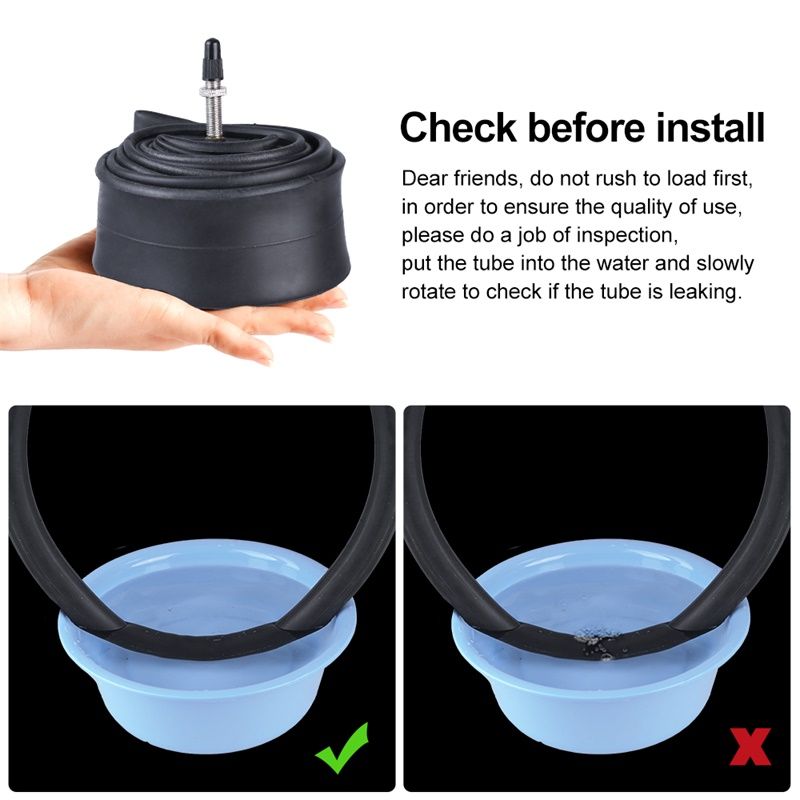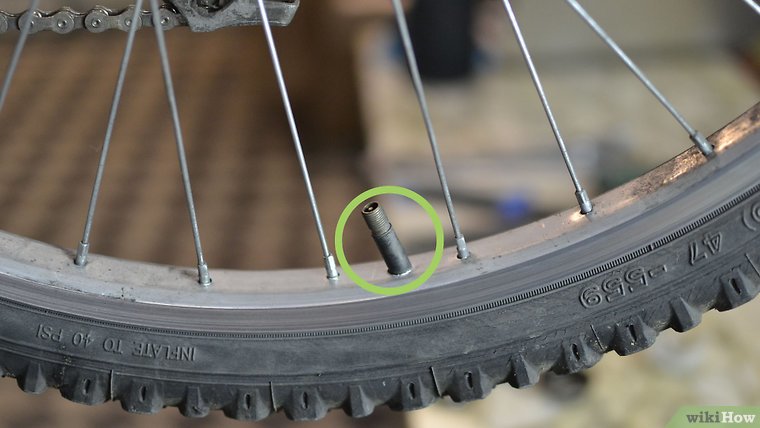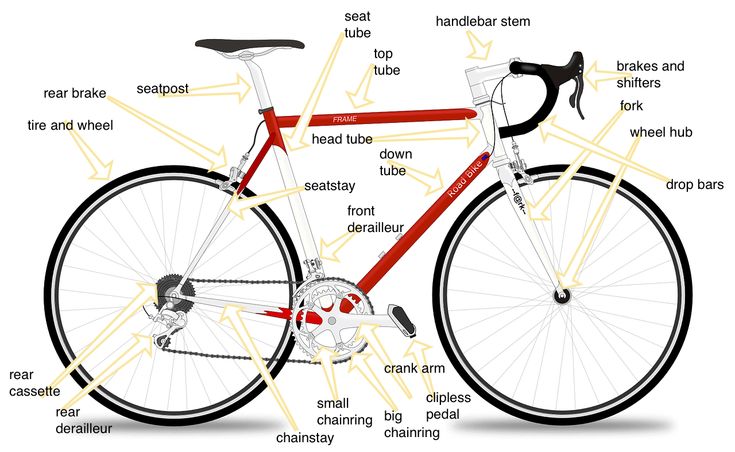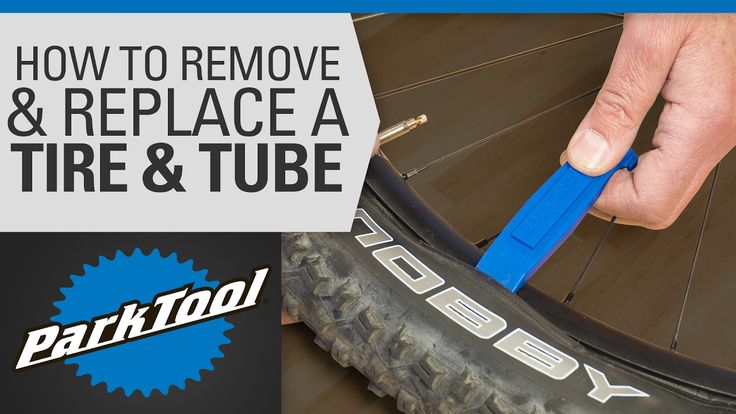SKI SNOWBOARD GEAR EDUCATION BIKE GEAR EDUCATION TEACH CHILDREN SKIING GEAR SIZING CHARTS
Once you learn this skill, flat tires won't be such a daunting task. It is very simple as long as you have the right tools and the proper technique.
Tools you'll need for the job:
Tire levers
Bike pump or CO2 inflator
New inner tube and/or tire
Firstly, remove the wheel from your bike. Then, nature usually does the second step for you, which is to deflate the tire completely. Once you have done these two steps, it's time to get down to business.
Use your lever to start removing half of the tire's bead (the part that touches the inside of the rim on both sides is the bead). To do this, you need to use the end of the lever that is hooked to get under the edge of the bead. Use the lever to peel the bead over the edge of the rim.
Once you have it over the rim, slide the lever along the rim to continue peeling the bead off one side of the rim. Always start peeling the bead off at the valve stem!
Now that you have half of the tire off the rim, you can easily pull the tube out. You can either chuck the tube, or find the hole and patch it. Next, check the inside of the tire for the object that punctured your tube. It is very common that you will find a thorn or piece of glass still embedded in your tire. To do this, take a rag, or carefully run your thumb along the inside of the tire where your tube touches it. While you're doing this, you can also inspect the outside tread of the tire to check for cuts. If you feel anything but smoothness, take a razor blade, awl or fingernail and remove the obtrusion.
So, we got a flat, figured out what caused the flat, now we need to replace the tube and be on our way. The best way to do this is to blow a tiny bit of air into the tube to give it shape before putting back into your tire. Start by putting the valve through the valve hole and work your way around, stuffing the lightly inflated tube back into the tire and rim. Once it's all the way in there, start at the
OPPOSITE SIDE from the valve and begin putting the bead back onto the rim with your hands. By starting at the opposite side of the valve, it will give you a tiny bit more room to get the last part of the bead over the rim, making life a little easier. So, work your way around the rim setting the bead back onto it. I like to use both hands working in opposite directions from each other. When it gets hard to put the bead on, deflate the rest of the air from your lightly inflated tube.
Start by putting the valve through the valve hole and work your way around, stuffing the lightly inflated tube back into the tire and rim. Once it's all the way in there, start at the
OPPOSITE SIDE from the valve and begin putting the bead back onto the rim with your hands. By starting at the opposite side of the valve, it will give you a tiny bit more room to get the last part of the bead over the rim, making life a little easier. So, work your way around the rim setting the bead back onto it. I like to use both hands working in opposite directions from each other. When it gets hard to put the bead on, deflate the rest of the air from your lightly inflated tube.
Now, the hardest part is the last bit. Some tire and rim combinations are worse than others, but most of the time you can do this with your hands. You will find that the last part of the tire's bead is the tightest. It is best if you can do this with your hands, but if necessity presents itself, carefully use the tire lever. The reason it is bad to use the tire lever is because you run the risk of pinching, and puncturing your new tube… So, grab the tire and tube and use your thumbs to lift the bead over the last bit of the rim. It might take a little bit of grunting, but 90% of the time this can be done with your hands.
The reason it is bad to use the tire lever is because you run the risk of pinching, and puncturing your new tube… So, grab the tire and tube and use your thumbs to lift the bead over the last bit of the rim. It might take a little bit of grunting, but 90% of the time this can be done with your hands.
You've done a great job so far, but you're not quite done! The next couple of steps are important so that you don’t cause your tube to explode in your face!
Once your tire is completely back on your rim it is time to pump it up. If you are using a CO2 inflator to do this, pay close attention! First, you want to push the stem into the tire to prevent the tube from being pinched under the bead of the tire. Then, add a little bit of air to your tube to give the tire shape. I usually put about 20-30 psi in the tire. Now, pick the tire up and spin it in your hand while holding the hub. Inspect the edge of the tire to make sure that the bead is "seated" against the rim evenly around the whole wheel. If it isn't, you will either see a bulge or a depression of the tire against the rim. Use your hands to either pull these depressions out, or push the bead down into the rim. This should be easily done with 20-30 psi in the tube. This is also another good time to look for any big cuts in the tire as the tube will be bulging if there is a cut. Once you're done inspecting, and everything looks good, it is safe to continue pumping your tire up to the specified psi, install the wheel on your bike, and continue on your way!
If it isn't, you will either see a bulge or a depression of the tire against the rim. Use your hands to either pull these depressions out, or push the bead down into the rim. This should be easily done with 20-30 psi in the tube. This is also another good time to look for any big cuts in the tire as the tube will be bulging if there is a cut. Once you're done inspecting, and everything looks good, it is safe to continue pumping your tire up to the specified psi, install the wheel on your bike, and continue on your way!
With a little bit of practice, this whole process can be done in about 10 minutes. With a lot of practice, you can do it in the rain in 5 minutes!
Written By: Brett Hartt (and 6 other contributors)
Difficulty
Easy
Steps
6
Time Required
Suggest a time??
Sections
2
Flags
0
This guide will show you how to remove an inner tube from a bicycle tire. The process is the same for both front and rear wheels, even though this guide demonstrates the process on the rear wheel. While some components on your bicycle may be different than those shown here, the process will be the same.
The process is the same for both front and rear wheels, even though this guide demonstrates the process on the rear wheel. While some components on your bicycle may be different than those shown here, the process will be the same.
Edit
Edit
Edit
Insert the flat part of a tire lever under the tire coping. Apply pressure to the other end of the lever to lift the tire up and out of the wheel.
Slide the lever around the circumference of the wheel to completely remove the tire.
Alternatively, if you have multiple tire levers, see if you can clip the first lever to a spoke to keep it in place. Then insert the second lever a few inches away. Clip it to a spoke. Insert the third lever a few more inches along. Take out the second lever and insert it it a few inches past the third. Work along the rim until the tire pops off.
Edit
Edit
Almost done!

Conclusion
Cancel: I did not complete this guide.
4 other people completed this guide.
with 6 other contributors
Badges: 52
+49 more badges

There is a lot of controversy on the net about whether a tube is put in a tubeless tire and what the consequences of repair are. Some users claim that in this case, the car behaves unpredictably. Others insist on the acceptability of the repair method.
Contents
Experts are also divided into two camps. On the one hand, put a similar wheel - harm the car. Opponents do not see anything terrible.
Opponents do not see anything terrible.
Before drawing conclusions and making a decision, all the advantages and disadvantages of the procedure must be carefully weighed.
The procedure has definite pluses and minuses, indicating the expediency of repair.
Dignity.
Disadvantages.
 Shock absorbers also wear out faster. nine0010
Shock absorbers also wear out faster. nine0010 Thus, as an emergency option, the method will fit for an accurate overcoming of 100-200 km. With constant use - it is recommended to change the wheel.
Self-installation in a tubeless tube is done as follows.

To eliminate the air bubble, some experts recommend slowly inflating the chute while lowering the nipple slightly into the socket.
The procedure is valid for all wheels, regardless of size, be it 14, 15 or r16.
Installing a camera in a modern cylinder on an alloy wheel is not allowed. The exception is the need for short-term rolling within 200 km. or use as a spare. nine0003
Damage to the rim or tire itself can provoke the need. Leakage is eliminated by inserting an independent pressure-holding cylinder.

If the slot is wide, the chamber may be forced out by internal pressure. This can cause the wheel to explode while driving. Simultaneously with the imposition of a "fur coat" - a reinforcing element, the operation of the cameras is possible. nine0005
Modern rims are equipped with special hump rings. The parts are designed to hold the tire cord in a pressed state.
If the tire continues to be used, due to the lack of a retaining element, it will quickly be torn off its seat.
The formation of a hernia on the tire indicates damage to the inner layer of the cord. If the fabric or metal base is destroyed, further operation of the product is categorically not recommended. nine0005
The same applies to installing a tube in a damaged tire. The additional insert does not have a reinforcing layer. The soft chamber is highly stretchable, making it useless to mount.
The soft chamber is highly stretchable, making it useless to mount.
Usually tubeless tires can deflate in three cases.
If there are no obvious punctures, pay attention to the above factors or install a conventional camera inside.
In some cases special patches are allowed. In case of serious punctures, a part sealing the hole is attached from the inside by vulcanization or special glue.
This repair is not possible in every case. Long cuts, torn holes are not subject to sealing. The patch is squeezed out through the hole, which eliminates the effect of the repair.
[ad-pc-mob-pa154]
The standard procedure for mounting a tubeless valve to a wheel involves the use of a special tool. nine0005
Pictured is a jtc 3926 nipple wrench:
The procedure is as follows:
Leave a review
Vladimir Gavrilov
Estimated reading time: 4 minutes
18945
Category: Service Auto
Wheel manufacturers perceive the rubber chamber as archaic. But sometimes it becomes indispensable for salvation from hernia and cuts.
But sometimes it becomes indispensable for salvation from hernia and cuts.
There are situations when it is not possible to repair a wheel. Let's imagine that at high speed the car flew into a large hole and damaged two or three wheels. Hernias appeared on them, and one even burst. There is only one spare tire, it is not safe to drive with a hernia. How to be? nine0005
Or another situation. The attackers pierced three tires at once with a knife, and the patch (or flagellum) does not hold air pressure at the cut site. Masters issue a strict verdict: for replacement. But where on the way to get new tires if there is no money? And if there is, it is difficult to quickly find suitable wheels. Perhaps the inexpensive old models of wheels that are on the car have already been discontinued and no longer sold. Cunning sellers in stores offer to take new, 2 or 4 wheels at once as a set to ensure the unity of the tread pattern and the identity of grip properties. But it's hopelessly expensive. nine0005
nine0005
You have to get out and look for temporary solutions to the problem. The most common of these is the installation of a camera in a tubeless tire.
It is strongly not recommended to do this, you can try it only in case of emergency. If you decide to experiment, then you immediately need to prepare for several troubles that may await on the road.
The fact is that a tubeless tire should work structurally without any layers inside. It has soft sidewalls that perform their functions only with uniform pressure inside the rubber. The tire then fits snugly to the disc, seizes it with its edges and, with the help of a sealant, sticks under the action of friction forces. nine0005
But if you stick a foreign layer there, the tire will work differently. Although the rubber chamber is stretched, in any case, it fits the tire from the inside loosely. The pressure on the edges is different. As a result, the rubber is deformed and poorly compressed from the sides. At high speeds, it works out bumps as it should. The car receives microplay, noticeable with active taxiing. As a result, due to the bending of the rubber, uneven tread wear begins. But this is not the worst. nine0005
At high speeds, it works out bumps as it should. The car receives microplay, noticeable with active taxiing. As a result, due to the bending of the rubber, uneven tread wear begins. But this is not the worst. nine0005
Worse, when a tire with a chamber inside, due to lack of downforce, breaks and disassembles during sudden braking or maneuvering. And this threatens a sharp loss of control. And then - how lucky.
In addition, an air gap in the form of a bubble is guaranteed to form between the tire and the bladder when the pump is inflated. At speed, such a blister moves inside the wheel and causes imbalance. The wheel beats and heats up, the steering wheel vibrates. Driving becomes not only dangerous, but also unpleasant. nine0005
However, you can use the camera to get to your home or workshop if the wheel is damaged.
The tire fitters will apply the patch. The chamber will hold the air pressure, and the tire, as an outer casing, will take the load. So you can go even better than on the dokatka. The main thing is not to forget to put such wheels on the rear axle and not to accelerate too fast. It is best to drive progressively, without acceleration, not higher than 80 km / h. It is absolutely impossible to brake sharply. If you follow these simple rules, a tubeless wheel with a camera will travel several hundred kilometers. And then the damaged tire can be replaced. It is not worth delaying the purchase of new wheels. The camera inside the tubeless is a time bomb. Someday it will explode. nine0005
So you can go even better than on the dokatka. The main thing is not to forget to put such wheels on the rear axle and not to accelerate too fast. It is best to drive progressively, without acceleration, not higher than 80 km / h. It is absolutely impossible to brake sharply. If you follow these simple rules, a tubeless wheel with a camera will travel several hundred kilometers. And then the damaged tire can be replaced. It is not worth delaying the purchase of new wheels. The camera inside the tubeless is a time bomb. Someday it will explode. nine0005
tips for motoristscar tires
Next article
Media news2
E-mail: nine0005
The main thing for the day
AiF.